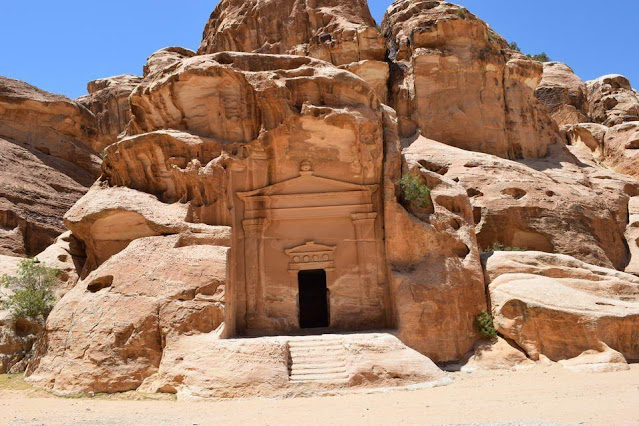The trail from Ras al-Feid was along rocky sandstone terrain with a steady upward climb for the next mile or so (2km). The desolate and barren landscape was constant with the occasional appearance of desert vegetation until I arrived at the outskirts of Petra Archaeological Park. A UNESCO World Heritage Site since 1985, the Park covers an area of 264,000m² of rocky mountains and the ancient city of Petra. Listed as one of the 7 Wonders of the World, Petra holds the history of the Nabatean people and a multitude of buildings carved into the rock some 2,000 years ago.
Entering a narrow canyon, I arrived at Little Petra, also known as Siq al-Barid (‘the cold canyon’). Archaeologists surmise that Little Petra was once a suburb of Petra. Consisting of three wide open spaces with buildings carved into the rock, Little Petra was connected by a small canyon of 1,480ft (450m) in length.The first building I stopped to explore was the Painted Biclinium. A double storey structure, it had a dining room on the upper floor that was accessed via a wide staircase followed by a narrow and weathered set of steps. Inside the biclinium was a niche (a recessed section of the room with a half-dome top) and on its curved ceiling was a well preserved painting of vines, grapes, birds, flowers and Cupids (a flute player and an archer). Primarily painted in a rich dark brown and ochre, elements of dark blue and green were also present. Following restoration in the late 2000s, gilding was also found on vine leaves. The artwork was carbon dated to sometime between 40BC and 25AD.
Back outside and a little further through the narrow canyon, the area opened up into a square and to my right in the rockface was what seemed to be a temple structure built on top of cave-like rooms beneath it. The temple façade consisted of four pillars topped with Nabatean horn capitals. The pillars were most likely for aesthetics since the building did not require any support as it was carved into the rock.
Trekking through another narrow section of the gorge, I arrived at another open space where a set of steps led up to a single door of a small building that once served as a tomb. A dark empty chamber I stepped outside and marvelled at the effort, the skills, the tools and the workforce needed two millennia ago to carve these structures.












No comments:
Post a Comment
It's so good to see you here . . .